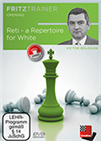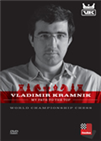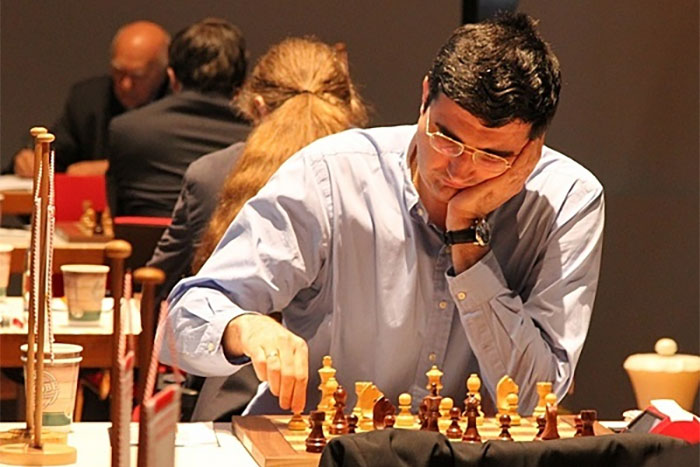In the context of modern chess Kramnik's departure from theoretical lines is not unusual. World Champion Magnus Carlsen has set a trend, as World Champions always do, to shift the main part of the battle to the middlegame and the endgame. Today's best players consider it impractical to allow their lower-rated opponents to play 25 moves of theory. White has a lot of options with his opening choices, as long as he's happy to just have a playable position.
Vladimir Kramnik has the utmost confidence in his ability to outplay his opponents in complex positions. His expertise in the Reti covers a wide array of possible pawn structures, many of which are of a “reversed color”variety.
The next example is a Benko/Benoni type of game, where a modest opening surprisingly transformed itself into a full-fledged ambitious middlegame once White's central pawns began to move forward.

[Event "TCh-RUS Men 2015"] [Site "Sochi RUS"] [Date "2015.05.02"] [Round "2.1"] [White "Kramnik, V."] [Black "Svidler, P."] [Result "1-0"] [ECO "A05"] [WhiteElo "2783"] [BlackElo "2729"] [Annotator "AlexYermo"] [PlyCount "60"] [EventDate "2015.05.01"] [EventType "team"] [EventRounds "9"] [EventCountry "RUS"] [WhiteTeam "Sibir (Novosibirsk)"] [BlackTeam "Bronze Horseman (St. Petersburg)"] 1. Nf3 Nf6 2. g3 d5 3. Bg2 g6 4. b3 $5 {Now it's a Double Fianchetto English with the colors reversed.} ({Instead of the routine} 4. d4 Bg7 5. c4) ({ It is important to White to oppose Black's Grunfeld bishop immediately, as} 4. O-O Bg7 5. b3 {would allow the opponent an option of} Ne4 $5 {First mentioned by Bent Larsen, this move forces White to close the diagonal with} 6. d4 { which was not in his plans. A recent blitz game between two young Russian stars proved the point:} c5 7. Bb2 Nc6 8. Na3 O-O 9. c3 Qa5 10. Rc1 Bf5 11. h3 Rad8 12. e3 e5 {and Black was already better in Fedoseev-Artemiev, 2016.}) 4... Bg7 5. Bb2 c5 6. c4 d4 {Svidler decided to grab some space.} ({A somewhat safer option is represented by} 6... O-O 7. cxd5 Nxd5 (7... Qxd5 {is thought to be dangerous,} 8. Nc3 Qf5 9. Rc1 {but perhaps this line can be rehabilitated if Black finds} Nc6 $5 ({White is clearly better after the passive} 9... Nbd7 $2 10. d4 {Sagar-Czarnota, 2017}) {welcoming complications in} 10. Na4 b6 11. b4 $6 (11. Ne5 Ne4 $1) 11... Nxb4 $1 12. Nh4 Qe6 13. Bxa8 Nd3+ 14. Kf1 Nxc1 15. Bxc1 g5 16. Nf3 Bd7 {[#] White's pieces are terribly disorganized.}) 8. Bxg7 Kxg7 9. O-O Nc6 10. Qc1 Qa5 11. Na3 (11. Nc3 $142 Nxc3 12. dxc3 $14) 11... Bg4 12. Nc4 Qc7 13. Qb2+ Nf6 14. e3 Rad8 15. Nfe5 Nxe5 16. Nxe5 Be6 17. Rfc1 Qb6 {Chigaev-Praggnanandhaa, 2016. Black is still under pressure to protect his Q-side pawns, but if he manages to to do so, he'll have some prospects to play for a win.}) 7. b4 Nfd7 $5 {An interesting idea going back to Miles-I.Sokolov, 1988} (7... O-O 8. O-O Nc6 ({Also known is} 8... Re8 9. d3 e5 10. bxc5 Nfd7) 9. b5 {White is always happy to chase that knight away.} Na5 10. d3 Qc7 11. Nbd2 e5 {[#] The game Artemiev-Li Chao, Blitz 2016 is very instructive. First White clears out the long diagonal for his bishop with the help of a standard knight trade:} 12. Ng5 h6 13. Nge4 Nxe4 14. Nxe4 Be6 {then it's time to trade another knight pair} 15. Nd2 Rae8 16. Nb3 $1 { giving Black a difficult choice between} Nxb3 ({and} 16... a6 17. bxa6 bxa6 18. Qd2 Nxb3 19. axb3 Rb8 20. Rxa6 Rxb3 21. Ba3) 17. axb3 b6 18. b4 {in both case White manages to get things going on the Q-side and distract Black from utilizing his advantage elsewhere on the board.}) 8. O-O Nc6 9. bxc5 ({Kramnik rejected the natural} 9. b5 {on account of} Nce5 10. Nxe5 Nxe5 11. d3 h5 $1 { where his king could have been troubled by the threat of h5-h4.}) 9... O-O 10. d3 Nxc5 11. Nbd2 {[#]} Rb8 (11... a5 12. Rb1 Re8 13. Ba3 Na6 14. Ne1 Nab4 15. Bxb4 axb4 16. Nc2 Rxa2 17. Bxc6 bxc6 18. Nxb4 {occured in the above mentioned Miles-I.Sokolov. It's hard for Black to prove he has sufficient compensation.}) 12. Ba3 Qa5 13. Qc1 {Kramnik's innovation.} ({Previously seen was} 13. Bxc5 Qxc5 14. Qa4 Bd7 15. Rab1 {Dizdar-Fedorov, 2003.}) 13... Na4 {Using the c3-square looks like the right plan with the bishop unobstructed by e7-e5.} 14. Nb3 Qc7 15. Qc2 Bd7 $6 ({Seeing what was about to happen, I can recommend taking some measures of putting pressure against the d3-pawn.} 15... Bf5 16. Rae1 Qd7 {does that, while keeping Na4 protected against Nxd4 ideas.}) 16. Rae1 {[#] It's remarkable how little Kramnik is troubled by that c3-square. He just follows his plan of removing the d4-pawn.} Rfd8 17. e3 $1 dxe3 18. fxe3 h6 $2 ( {The last chance to stir some trouble was} 18... Bc3 19. Rd1 Bb4 {but it's counterintuitive to remove the Bishop from its Grunfeld spot and leave the king undefended.}) 19. d4 {Now it's time for a classic Botvinnik... pardon, Kramnik pawn roller.} Bf5 20. e4 Bg4 21. e5 Nb6 22. Nh4 $1 Nxd4 23. Qf2 Qxc4 24. Re4 $1 {[#] The rook in the middle has a decisive effect, we'll see the same idea later in Kramnik-Aronian.} Be6 25. Nxd4 Bd5 26. Ne6 $1 {Interefence to hit f7.} Bxe6 27. Rxc4 Nxc4 28. Bxe7 Rd2 29. Qxa7 Bxe5 30. Nf3 Bc7 1-0
Sometimes, White's unassuming handling of the opening moves may lure Black into a false sense of security. When White starts off with Ng1-f3 and g2-g3, it doesn't mean he isn't looking to open it up, should Black allow himself too many liberties with his move order. The next game illustrates the hidden dangers awaiting Black in the early ...b5 variation.

[Event "World Rapid 2015"] [Site "Berlin GER"] [Date "2015.10.10"] [Round "2.34"] [White "Kramnik, V."] [Black "Ghaem Maghami, E."] [Result "1-0"] [ECO "A05"] [WhiteElo "2777"] [BlackElo "2596"] [Annotator "AlexYermo"] [PlyCount "27"] [EventDate "2015.10.10"] [EventType "swiss (rapid)"] [EventRounds "15"] [EventCountry "GER"] 1. Nf3 Nf6 2. g3 b5 {For many players who view White's move order as an introduction to the Catalan, this is the way to interfere with the opponent's intentions.} 3. Bg2 ({For the interesting alternative} 3. e3 {see the next game.}) 3... Bb7 4. O-O c5 5. d3 g6 ({Somewhat more reliable is} 5... e6 { [#] Black chooses a flexible, Hedgehog-like structure in the center, inviting White to overextend on the K-side.} 6. e4 d6 7. Nc3 (7. a4 {was Carlsen's choice against Vachier-Lagrave in Norway Blitz 2015. The game continued} b4 8. Nbd2 Be7 9. Nc4 O-O 10. Re1 Nbd7 ({More logical seems} 10... Nc6 11. a5 a6 12. e5 Nxe5 (12... Ne8) 13. Nfxe5 Bxg2 14. Nxf7 Rxf7 15. Kxg2 Qd7 16. f4 Re8 17. Qf3 Bd8) 11. Bf4 {and here} d5 {should not have worked out well for Black} ( 11... e5 $142 12. Be3 Re8 13. c3 a5) 12. Nd6 Bc6 13. Ng5 Nb6 {[#]} 14. Ndxf7 $1 {was a brilliant idea by Magnus. Too bad he spoiled the winning position he obtained after} Rxf7 15. Bh3 Bd7 16. a5 e5 17. axb6 Bxh3 18. b7 Rb8 19. Bxe5 Rxb7 20. Nxh3 $2 (20. Nxf7 Kxf7 21. Bxf6 Bxf6 22. Qh5+ $18) 20... Qd7 21. Nf4 dxe4 22. dxe4 Ng4 {etc.}) 7... b4 8. Ne2 Nbd7 9. Ng5 $5 {I believe this idea (in similar positions) belongs to Alexander Morozevich. White is hoping to provoke a weakening move h7-h6 while clearing the f-file out for his pawn storm.} Qc7 10. f4 Be7 11. h3 O-O 12. g4 Rfc8 13. Be3 a5 14. Ng3 c4 15. Rc1 cxd3 16. cxd3 Qd8 17. f5 Rxc1 18. Bxc1 e5 {Grischuk-Leko, Sport Accord Blitz, 2013 went its logical way at least up to this point, where White should have gone on with} 19. Nxf7 (19. Nf3 $6 d5 20. g5 dxe4 21. Nh2 {and despite having a suspect position Grischuk went on to win that game.}) 19... Kxf7 20. g5 { keeping the situation tense and double-edged.}) 6. e4 d6 (6... Bg7 7. e5 Nd5 8. d4 $1 {and once again, Black's hypermodern double fianchetto is exposed by White's central strategy.}) 7. d4 $1 {A great move, showing how flexible Kramnik's thinking is. Forget the Closed Sicilian, we're going to play the g3 Dragon, only without the white knight on c3. We will see shortly why it is important.} cxd4 (7... Nxe4 8. Ng5 d5 9. dxc5 Nf6 10. b4 a5 11. c3 Bg7 12. a4 $1 {and White's superior development will leads to substantial gains on the Q-side. On} h6 {even} 13. Nxf7 $5 Kxf7 14. axb5 {is possible.}) (7... Bxe4 8. dxc5 d5 9. Nc3 Bg7 10. Nxe4 Nxe4 11. Ng5 {is similar, only with White enjoying his bishop pair.}) 8. Nxd4 a6 9. Re1 {[#]} e5 {Ghaem couldn't stand watching out for e4-e5 on every move.} ({The right move was} 9... Nbd7 $1 {based on the following line:} 10. e5 (10. a4 $142 b4 11. c3 bxc3 12. Nxc3 {keeping the e4-e5 break in reserve.}) 10... Bxg2 11. exf6 Bb7 12. fxe7 Bxe7 13. Bh6 Ne5 14. f4 Qb6 $1 15. fxe5 dxe5 16. Rxe5 O-O-O 17. c3 Bf6 {with serious counterchances. }) 10. Nb3 ({Even the immediate} 10. a4 {can come into consideration.}) 10... Bg7 11. a4 $1 b4 {Now the purpose of delaying Nb1-c3 is revealed. There's no attack on that knight, and White gets a crucial tempo to do his thing.} 12. a5 O-O 13. Ra4 Bc6 ({In case of the relatively better} 13... Nc6 {White still stays on top:} 14. N1d2 Bc8 15. Nc4 Be6 16. Qd3 {etc.}) 14. Rxb4 $16 {Kramnik won a pawn, and the rest was history: 1-0 in 57 moves.} 1-0

The Reti, a flexible attacking opening
The Nimzo-Indian, the Gruenfeld and the King's Indian Defence are three incredibly uncomfortable defences to meet. This hypermodern DVD gives new ideas on how to squash these setups with sound, positional play based on double fianchetto systems.
In contrast to the game above, in the following game Pentala Harikrishna played solid. Having reached a near symmetrical position after 16 moves of play, he must have thought he had equalized. It took one surprising move from Kramnik to prove it wasn't the case.

[Event "4th Norway Chess 2016"] [Site "Stavanger NOR"] [Date "2016.04.28"] [Round "8.5"] [White "Kramnik, V."] [Black "Harikrishna, P."] [Result "1-0"] [ECO "A04"] [WhiteElo "2801"] [BlackElo "2763"] [Annotator "AlexYermo"] [PlyCount "93"] [EventDate "2016.04.19"] [EventType "tourn"] [EventRounds "9"] [EventCountry "NOR"] [EventCategory "21"] 1. Nf3 e6 2. g3 b5 3. e3 $5 {Usually White avoids this move in the Catalan, but here the bishop hits the exposed pawn to gain a tempo.} a6 4. Bg2 Bb7 5. O-O Nf6 6. b3 c5 7. c4 {It's some sort of an English now.} Be7 (7... bxc4 8. bxc4 Be7 9. Nc3 O-O 10. Rb1 {makes it look like the black bishop stepped out too soon, while the counterpart on c1 is wisely taking its time.}) 8. Nc3 O-O $1 9. d4 (9. cxb5 $2 axb5 10. Nxb5 Ba6) 9... d5 {Hari makes his choice towards a classical approach of counterstrike in the center.} ({Benoni setup with a passive Be7 is not to everyone's liking:} 9... Qb6 10. d5 exd5 11. cxd5 d6 12. e4 Nbd7 13. h3 $14) 10. cxd5 Nxd5 11. Nxd5 Bxd5 12. dxc5 {Kramnik relies on his vast experience in symmetrical Queen's Gambit-type of positions.} Bxc5 { Maybe a slight inaccuracy.} (12... Nd7 $142) 13. Qe2 Nd7 14. Rd1 Qe7 15. Bb2 Rac8 16. Rac1 Bb7 $2 {An unforced error.} ({Kramnik showed no inclination toward e3-e4, so the prophylactic} 16... h6 {was the most appropriate here.}) 17. Ng5 $1 {A typical shot in many Queen's Indian positions, but here the white queen doesn't attack h7, so what is this about?} Bxg2 18. Kxg2 {[#]} f5 { Not an easy decision to make.} (18... Nf6 19. Bxf6 Qxf6 20. Nxh7 ({or even} 20. Qh5 Qg6 21. Qxg6 hxg6 22. Rd7 $16) 20... Kxh7 21. Qh5+ {nets White a free pawn. }) ({The point is to use the power of Bb2 to provoke a serious weakening of Black's position.} 18... Nb6 19. Qg4 f5 20. Qh5 h6 21. Nf3 $14) ({Of all possible variations} 18... Rfd8 19. Qh5 h6 20. Ne4 Ba7 {[#] is the most striking. White wins on the spot with} 21. Rxd7 $3 Qxd7 22. Qg4 f5 23. Nf6+ { [#]} Kf7 (23... Kh8 24. Qg6 Qb7+ 25. Kh3) 24. Qh5+ g6 25. Qxh6 Qb7+ 26. Kh3 Rh8 27. Nh7 $1) 19. e4 $1 {The ghost of an attack against f2 doesn't scare Vladimir.} h6 20. Nf3 ({Also} 20. Nh3 fxe4 21. Nf4 {looked pretty good for White.}) 20... Nf6 21. exf5 exf5 22. Qxe7 Bxe7 23. Nd4 {[#]White's advantage has crystallized. His bishop is much better placed, and Black has to worry about his exposed pawns on both wings.} Rxc1 24. Rxc1 Nd5 25. Ne6 Rf7 26. Rc8+ Kh7 27. Ra8 $16 {Just like that Kramnik won a pawn and forced resignation exactly 20 moves later.} f4 28. Rxa6 fxg3 29. hxg3 Bf6 30. Bc1 Re7 31. Rd6 Nc3 32. a3 Kg8 33. Bb2 Ra7 34. Rc6 Nd5 35. Bxf6 Nxf6 36. Rc7 Rxa3 37. Rxg7+ Kh8 38. Rg6 Ne4 39. Rxh6+ Kg8 40. Rh4 Nd2 41. b4 Nc4 42. Nc7 Ra2 43. Re4 Nd6 44. Rd4 Nf5 45. Rd8+ Kf7 46. Nxb5 Rb2 47. Rd3 1-0
In his mastery of the Modern Reti, Kramnik draws heavily from his general experience in 1.d4 openings. Every possible pawn structure is an open book for him. When the next game went off the rails early, Vladimir knew exactly what to do.

[Event "GCT Blitz YourNextMove"] [Site "Leuven BEL"] [Date "2016.06.19"] [Round "3.3"] [White "Kramnik, V."] [Black "Aronian, L."] [Result "1-0"] [ECO "A07"] [WhiteElo "2812"] [BlackElo "2792"] [Annotator "AlexYermo"] [PlyCount "71"] [EventDate "2016.06.19"] [EventType "tourn (blitz)"] [EventRounds "18"] [EventCountry "BEL"] [EventCategory "22"] 1. Nf3 d5 2. g3 Nf6 3. Bg2 e6 4. O-O Be7 5. d3 O-O 6. Bf4 $5 {[#] and uncorks a fresh idea.} ({Kramnik avoids the routine} 6. Nbd2 c5 7. e4 Nc6 {etc.}) 6... Nc6 $5 {Levon doesn't want to concede the originality award.} ({I think the point was once again to delay the development of Nb1. In case of} 6... c5 { White can offer an enterprising pawn sac} 7. e4 {which Black will politely decline,} Nc6 (7... dxe4 8. dxe4 Qxd1 9. Rxd1 Nxe4 10. Ne5 Nf6 11. c4 $44 { Big time Catalan pressure, don't you think?}) 8. e5 Nd7 9. h4 {Now we can see the point of White's play. He plans to continue with c2-c4 and Nb1-c3 putting real pressure on the d5-pawn. Black may have the answer in} f6 $5 {but then} 10. exf6 Bxf6 11. Nc3 $13) 7. d4 {Here we go. Just as in the Kramnik-Ghaem Maghami game Vladimir shows no inhibitions about moving his d-pawn twice. Here it has a clear point of stopping e6-e5 to leave Black with an awkward Chigorin setup without his light-squared bishop out on g4.} b6 {So, it's going to be another Queen's Indian Defense, an opening Kramnik has always had success against.} 8. c4 Bb7 9. Nc3 Na5 {[#] Instead of going to either d7 or a6, the black knight has parked on the sidelines.} 10. cxd5 Nxd5 (10... exd5 11. Qc2 Ne4 12. Rad1 Nxc3 13. Qxc3 $14) 11. Nxd5 Bxd5 $2 (11... Qxd5 12. e4 Qb5 { would have saved Levon two tempi, and therefore made it more likely he could have gotten away with} 13. Re1 Qxb2) 12. Qc2 Rc8 13. e4 Bb7 14. Rad1 Qd7 15. Ne5 Qb5 16. Rfe1 Rfd8 {[#] Although anybody would love to be White here, how many can handle this position the way Kramnik did?} 17. Bh3 $1 {Setting up d4-d5 and eyeing the f7-e6 pawns for tactical shots.} Bb4 18. Re3 Bd6 19. d5 $1 Bxe5 20. Bxe5 Nc4 21. Rb3 Qa4 22. Rd4 $18 {Very impressive rooks deployment.} Ba6 23. dxe6 Rxd4 24. Bxd4 Rd8 25. exf7+ Kf8 26. Qc3 Ne5 27. Bc5+ $1 bxc5 28. Qxc5+ Rd6 29. Qxe5 Rd1+ {[#]} 30. Bf1 $6 {A first slip in the game allowed by White.} (30. Kg2 Bf1+ 31. Kf3 Bxh3 32. Rb8+ Kxf7 33. Qh5+ Ke7 34. Qh4+ Kf7 35. Qxh3 Rd3+ 36. Kf4 $18) 30... Bxf1 (30... Rxf1+ 31. Kg2 Qc6 32. Rb8+ Kxf7 33. Qf5+ Qf6 34. Qh5+ Qg6 35. Qd5+ Ke7 36. Rg8 $1) 31. Qc5+ ({A more decisive continuation was available:} 31. Rb8+ Kxf7 32. Qf5+ Ke7 33. Qf8+ Ke6 34. Re8+ Kd7 35. Re7+ Kc6 36. Qe8+) 31... Kxf7 32. Rf3+ $4 {Still, it was a blitz game, so we will forgive Kramnik's missteps.} (32. Qh5+ Ke7 33. Qxd1 $18) 32... Ke6 33. Qf5+ Kd6 34. Qf8+ Kc6 $4 {Same goes for Aronian's return error.} (34... Ke6 {and White has to give perpetual.}) 35. Qe8+ Kb7 36. Qxa4 {Perhaps only now Levon noticed that his rook was under attack, so there was no Bh3#.} 1-0

Reti - A Repertoire for White
Starting with 1.Nf3 the Reti is designed for those players who like strategy, manoeuvres and plans. Bologan presents a repertoire based on 1.Nf3 giving you options for all major replies.
Still, the main battles will be fought in classical 1...d5 lines of the Reti. Below are two recent examples, one each for the ...Bf5 and ...Bg4 variations. I offer only brief notes, leaving the rest to my dear readers to figure out on their own.

[Event "42nd Olympiad 2016"] [Site "Baku AZE"] [Date "2016.09.12"] [Round "10.3"] [White "Kramnik, V."] [Black "Adhiban, Baskaran"] [Result "1-0"] [ECO "A07"] [WhiteElo "2808"] [BlackElo "2671"] [Annotator "AlexYermo"] [PlyCount "91"] [EventDate "2016.09.02"] [EventType "team"] [EventRounds "11"] [EventCountry "AZE"] [WhiteTeam "Russia"] [BlackTeam "India"] [WhiteTeamCountry "RUS"] [BlackTeamCountry "IND"] 1. Nf3 d5 2. g3 Nf6 3. Bg2 Bf5 {Back to the old Lasker setup.} 4. O-O c6 5. d3 e6 (5... h6 6. c4 e6 7. cxd5 exd5 8. Qb3 $1 {preparing e2-e4. White had some edge after} Qb6 9. Qc2 Be7 10. Nc3 O-O 11. e4 Bh7 ({or} 11... dxe4 12. dxe4 Bh7 13. Be3 Qa6 14. Rad1 Nbd7 15. Qb3 {Bartholomew-Yermolinsky, Twin Ports 2016}) 12. Be3 Qa6 13. Rad1 Nbd7 14. h3 Rad8 15. Rfe1 Bb4 16. e5 {That's what I was afraid of when I played John.} Ne8 17. a3 Be7 18. Qd2) 6. Nh4 Bg4 7. h3 Bh5 8. Qe1 $1 {White's going after that bishop.} Be7 9. f4 {The Dutch setup!} Nfd7 10. Nf3 f5 $1 {[#] Baskaran Adhiban goes for the most principled reply.} (10... Bxf3 11. Bxf3 d4 12. c3 e5 13. Na3) 11. e4 Bxf3 $6 {Perhaps unnecessary.} ( 11... O-O {Stefanova-Tomashevsky, Qatar 2015.}) 12. Bxf3 O-O 13. Nc3 $14 fxe4 14. dxe4 d4 15. Nd1 $1 {The knight will have much better prospects staying away from e2.} e5 16. Nf2 c5 17. Qe2 Nc6 18. Bg4 {The absence of of its counterpart opens new venues for White's light-squared bishop.} Kh8 19. Be6 exf4 ({Still, Black would have been fighting on equal terms, had he stuck to the plan dictated by his pawn majority on the Q-side.} 19... Qc7 20. f5 (20. Nd3 b5) 20... Nd8 21. Bd5 Nb6) 20. gxf4 {[#]} g5 $6 {Baskaran Adhiban is aggressively fighting for the e5-square, but his king's weakened position proves to be too much to overcome.} 21. Ng4 $1 gxf4 22. Bxf4 Qe8 23. e5 {Who's got the e5-square now?} Bh4 24. Bc4 Qg6 25. Kh1 Bg5 26. Bh2 Nb6 27. Bd3 Qe6 28. Qe4 Qd5 29. e6 $18 Rae8 30. Rxf8+ Rxf8 31. Ne5 ({Simpler and winning enough was} 31. Rg1) 31... Qxe4+ 32. Bxe4 Nd8 33. a4 $2 (33. Nd7 Nxd7 34. exd7 Rf7 35. Be5+ Bf6 36. Bd5 Bxe5 37. Bxf7 Nxf7 38. Rf1 $18) 33... Nxe6 34. a5 Nc8 35. Nd7 Re8 36. Be5+ Ng7 37. Rg1 Bh6 38. Bxb7 Ne7 39. Nf6 Rf8 40. Be4 Ng8 41. Nxh7 Re8 42. Ng5 Re7 43. Bd3 Bxg5 44. Rxg5 Nh6 45. Bxg7+ Rxg7 46. Rh5 1-0
The next game is a fascinating struggle against the young German GM Bluebaum. Kramnik finds himself forced to sacrifice, but gets proper compensation. To his credit, Bluebaum holds his own for a very long time.

[Event "45th GM 2017"] [Site "Dortmund GER"] [Date "2017.07.23"] [Round "7.3"] [White "Kramnik, V."] [Black "Bluebaum, M."] [Result "1-0"] [ECO "A07"] [WhiteElo "2812"] [BlackElo "2642"] [Annotator "AlexYermo"] [PlyCount "69"] [EventDate "2017.07.15"] [EventType "tourn"] [EventRounds "7"] [EventCountry "GER"] [EventCategory "19"] 1. Nf3 d5 2. g3 Bg4 3. Bg2 e6 4. O-O Nf6 5. d3 Be7 6. h3 Bh5 7. c4 c6 8. Qb3 Qc8 (8... Qb6 9. Be3 (9. Qc2) 9... Qxb3 10. axb3 a6 11. g4 Bg6 12. Ne5 Nbd7 13. Nxg6 hxg6 14. Nc3 O-O 15. Rac1 {occured twice in Meier-Karjakin, Chess.com Blitz 2017}) 9. g4 Bg6 10. cxd5 (10. Bf4 O-O 11. Rc1 Nbd7 12. Nc3 Nc5 {leads White nowhere.}) 10... cxd5 11. Bf4 Nc6 12. Nc3 O-O 13. Rac1 Qd7 {[#]} 14. Ne5 {Kramnik chooses a logical plan of removing the black knight from c6.} ({An interesting alternative was} 14. e4 $5) 14... Nxe5 15. Bxe5 h5 $1 {Active counterplay.} 16. g5 Ne8 17. f4 Bc5+ 18. d4 Bb6 {The centralized white bishop is in danger, and Kramnik is practically forced to sacrifice.} 19. f5 Bxf5 20. Rxf5 exf5 21. Nxd5 Qe6 22. Kh1 Rd8 23. Qf3 {Vladimir must have figured out he had sufficient long-term compensation.} ({Otherwise, he might have been tempted to try} 23. g6 $5) 23... g6 24. e3 Kh7 $6 (24... Rd7 25. h4 Bd8 {would help to cover f6, enabling the knight to come to e4.}) 25. Nf4 Qe7 26. Qg3 Bc7 {[#]} 27. Rxc7 $1 {White paints with the broadest strokes. We expect nothing else from Vladimir Kramnik.} Nxc7 28. Bf6 Qb4 29. Nxh5 gxh5 30. g6+ Kg8 31. Qg5 {Up to this point the young German GM had been able to keep pace with his fearsome opponent, but one move spoiled it all.} h4 $4 {A time trouble error.} (31... Nd5 32. Bxd8 Qd6 33. gxf7+ Kxf7 34. Qxh5+ Kg8 $13) 32. Qh6 Qe1+ 33. Kh2 Qg3+ 34. Kg1 Qe1+ 35. Bf1 ({After} 35. Bf1 Qg3+ 36. Kh1 Qf3+ 37. Bg2 Qd1+ 38. Kh2 {the checks run out.}) 1-0

My Path to the Top
On this DVD Vladimir Kramnik retraces his career from talented schoolboy to World Champion in 2006. With humour and charm he describes his first successes, what it meant to be part of the Russian Gold Medal team at the Olympiad, and how he undertook the Herculean task of beating his former mentor and teacher Garry Kasparov.
Previous articles on World Champions by Alex Yermolinsky:








